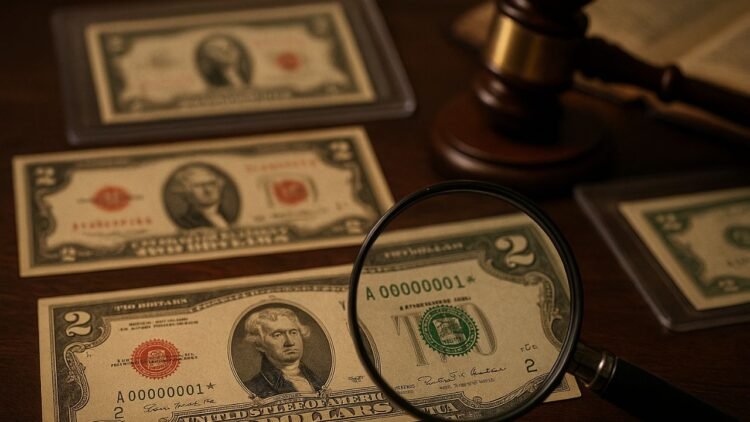Every few months, social posts claim that rare $2 bills are worth $71,000.
The truth: a handful of exceptionally scarce notes (usually older 1928-series star notes, dramatic printing errors, or elite serial numbers in top condition) can reach five figures at auction, but most modern bills are still worth $2.
Your value depends on series, grade, rarity, and demand, not the headline alone.
What Actually Makes A $2 Bill Valuable
- Star Notes (★): Replacement notes printed in smaller quantities. Older star notes—especially from the 1928 series—can be highly sought after. Modern stars may carry small to moderate premiums unless the run is scarce and the condition is superb.
- Fancy Serial Numbers: Collectors pay more for ladders (12345678), radars (ABCDCBA), repeaters (ABABAB), solids (11111111), and ultra-low numbers (00000001–00000100). Combine a fancy serial with uncirculated grade and prices can jump.
- Major Errors: Severe misalignments, inverted or missing elements, and mismatched serials are popular—especially when third-party graded.
- Older Large-Size Types: Nineteenth and early twentieth-century Legal Tender and other $2 types can command strong prices due to age and scarcity.
- Condition (Grade): From heavily circulated to Gem Uncirculated, grade can turn a $20 note into a thousands-of-dollars note when rarity is present.
$2 Bill Categories And Typical Market Ranges*
| Category | What To Look For | Typical Range* | Why It’s Valuable |
|---|---|---|---|
| 1976–Present Regular Notes | No star, common serials, circulated | $2–$6 | Large printings; widely saved since 1976 |
| 1976–Present Star Notes | Star (★) in serial, crisp | $5–$900+ | Smaller runs; premiums rise with grade/scarcity |
| Fancy Serial Numbers | 00000001, 12345678, RADAR, repeaters | $100–$20,000+ | Serial rarity + high grade drives demand |
| Major Error Notes | Severe misprints, mismatched numbers | $200–$5,000+ | Authentic, dramatic errors are collectible |
| 1928 Red-Seal Star Notes | Red seal + ★, certified | $1,000–$80,000+ | Scarce replacements with strong auction demand |
| 19th-Century Types | Large-size designs, different vignettes | $500–$10,000+ | Historic pieces with low survivors |
*Ranges are broad, market-based estimates; your note’s series, rarity, and grade determine where it lands.
How To Check Your $2 Bill (Fast Checklist)
- Identify The Series: Find the year (e.g., 1976, 1995, 2003, 2013, 1928). Pre-1930s notes can be far scarcer than modern issues.
- Look For A Star: A ★ at the end of the serial indicates a replacement note. Older stars often carry meaningful premiums.
- Scan The Serial: Hunt for low numbers, ladders, radars, or repeaters. Unusual patterns matter most when the note is uncirculated.
- Check For Errors: Obvious off-center prints, mismatched numbers, or missing layers are worth investigating.
- Assess Condition: Crisp, original, uncirculated notes are most desirable. Consider third-party grading (e.g., PMG, PCGS Banknote) before selling.
- Compare Realistic Prices: Use recent auction results and reputable dealer price lists to benchmark expectations. Avoid hype-only claims.
Key Facts About The Modern $2 Note
- The modern $2 Federal Reserve Note returned to circulation in 1976 for the U.S. Bicentennial and features Thomas Jefferson on the front and the Declaration of Independence vignette on the back.
- Because many people saved 1976 notes, typical examples—even crisp ones—often trade near face value, unless paired with a fancy serial, star, or major error.
The buzz about $2 bills worth $71,000 is based on rare, exceptional cases—not everyday wallet finds.
Real money is possible, but it comes from the right mix of rarity (star notes, special serials, major errors), older series, and top-tier condition.
If you think you have something special, verify the series, look for a star or fancy serial, evaluate condition, and compare to recent market results.
That’s the smart way to separate viral hype from genuine value.
FAQs
Are 1976 $2 bills rare?
No. Most were saved when reintroduced, so they’re generally common and worth around face value unless they have fancy serials, star notes, or errors.
What is a star note and why does it matter?
A star note (★) is a replacement for a misprinted note, usually printed in smaller quantities. Older stars—especially 1928—can be highly valuable in uncirculated grades.
How do I get the best price for a rare $2 bill?
Confirm authenticity and grade through a trusted third-party service, research recent sales, and consider selling via a reputable auction house to reach serious collectors.
